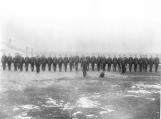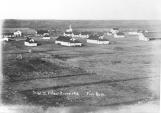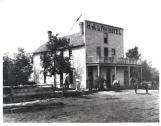1
Following the Riel Rebellion and fears of being attached by Métis rebels, the Canadian Government decided to increase the number of its members and temporarily moved its headquarters to Fort Edmonton.This soon proved to be an issue of contention for Griesbach as the men started to complain about the conditions inside the overcrowded barracks.
Unsavory characters from the last recruitment were the catalysts of mutiny. For Inspector Griesbach, this was a serious matter. Not only would it make or break the reputation of the force, it put his reputation on the line.
2
The Big Buck4
Following the halt of the rebellion, unsanitary conditions, overcrowding and discontent amongst the new recruits, bred the force's first "big buck". Griesbach recalls the event and how its outcome would either exonerate or annihilate his position as Commanding Officer:6
"In the spring of 1886, a mutiny broke out, largely attributed to the poor quarters, over-crowding and so forth. Some of the new NCO's were not to the mark and some of the men were not of good quality.In subsequent years this mutiny was known amongst the men as the 'big buck'. In military mutinies, there used to be and there probably still is, the general doctrine that the Commanding Officer is responsible for a mutiny; that the Commanding Officer must be given an opportunity of restoring order; that if he succeeds in doing this in a satisfactory manner he cures, to some extent, his offence in having a mutiny at all; the mutineers, being horsemen, still continued to look after their horses but otherwise performed no duties.
My father induced the mutineers to take the horses out on an exercise ride, meanwhile keeping in the Fort stout NCO's and reliable men."
8
"When the 'ride' returned the mutineers found themselves surrounded by officers, NCO's and reliable men with their rifles in hand ready for action. The ring-leaders of the mutineers were then arrested and confined in the guard room.Next morning they were brought before my father, charged with mutiny, and their case was remanded to the Commissioner sitting in Regina. They were then bundled into sleighs and under a suitable escort set out for Calgary, accompanied by the witnesses and necessary statements and the like.
On arrival at Regina, they were sentenced to various terms of imprisonment and dismissed from the force and the 'big buck' was over.
The Commissioner then came to Edmonton to investigate the conditions complained of. He found that there had been overcrowding, that the quarters were unfit and my father received a clean bill."
9
The New Fort11
The spirit of the police and the old fashioned way of dealing with confrontational situations was a "mixture of bluff and called for courage physical strength and determination".The new barracks were built in 1887, with a real house constructed for the Commanding Officer. The home of W. H. Griesbach was serviced by a "procession of trusty prisoners".
12
The Outer Limits14
The Half Way Hotel was a popular rest point for travelers for in 1895, by Order of Council, the old Fort Trail was deemed for public use. At Oliver, the trail made a sharp turn east to include the Half Way House along its route. It was a regular stop and frequently visited by the officer on his patrol.This famous landmark was rebuilt after a fire in 1896 and throughout the next few years incorporated a few changes, including a balcony, accompanying shed and a barn. The last record of its occupancy was noted by the Edmonton Bulletin in 1928.



